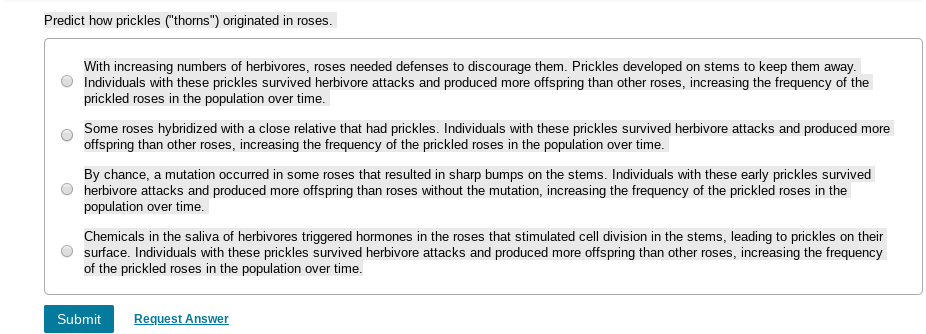Predict how prickles ("thorns") originated in roses. With increasing numbers of herbivores, roses needed defenses to discourage them. Prickles developed on stems to keep them away. Individuals with these prickles survived herbivore attacks and produced more offspring than other roses, increasing the frequency of the prickled roses in the population over time. Some roses hybridized with a close relative that had prickles. Individuals with these prickles survived herbivore attacks and produced more offspring than other roses, increasing the frequency of the prickled roses in the population over time. By chance, a mutation occurred in some roses that resulted in sharp bumps on the stems. Individuals with these early prickles survived herbivore attacks and produced more offspring than roses without the mutation, increasing the frequency of the prickled roses in the population over time. Chemicals in the saliva of herbivores triggered hormones in the roses that stimulated cell division in the stems, leading to prickles on their surface. Individuals with these prickles survived herbivore attacks and produced more offspring than other roses, increasing the frequency of the prickled roses in the population over time. Request Answer Submit
Predict how prickles ("thorns") originated in roses. With increasing numbers of herbivores, roses needed defenses to discourage them. Prickles developed on stems to keep them away. Individuals with these prickles survived herbivore attacks and produced more offspring than other roses, increasing the frequency of the prickled roses in the population over time. Some roses hybridized with a close relative that had prickles. Individuals with these prickles survived herbivore attacks and produced more offspring than other roses, increasing the frequency of the prickled roses in the population over time. By chance, a mutation occurred in some roses that resulted in sharp bumps on the stems. Individuals with these early prickles survived herbivore attacks and produced more offspring than roses without the mutation, increasing the frequency of the prickled roses in the population over time. Chemicals in the saliva of herbivores triggered hormones in the roses that stimulated cell division in the stems, leading to prickles on their surface. Individuals with these prickles survived herbivore attacks and produced more offspring than other roses, increasing the frequency of the prickled roses in the population over time. Request Answer Submit
Science Of Agriculture Biological Approach
5th Edition
ISBN:9780357229323
Author:Herren
Publisher:Herren
Chapter4: The Science Of Genetics
Section: Chapter Questions
Problem 2SLA
Related questions
Question
please help

Transcribed Image Text:Predict how prickles ("thorns") originated in roses.
With increasing numbers of herbivores, roses needed defenses to discourage them. Prickles developed on stems to keep them away.
Individuals with these prickles survived herbivore attacks and produced more offspring than other roses, increasing the frequency of the
prickled roses in the population over time.
Some roses hybridized with a close relative that had prickles. Individuals with these prickles survived herbivore attacks and produced more
offspring than other roses, increasing the frequency of the prickled roses in the population over time.
By chance, a mutation occurred in some roses that resulted in sharp bumps on the stems. Individuals with these early prickles survived
herbivore attacks and produced more offspring than roses without the mutation, increasing the frequency of the prickled roses in the
population over time.
Chemicals in the saliva of herbivores triggered hormones in the roses that stimulated cell division in the stems, leading to prickles on their
surface. Individuals with these prickles survived herbivore attacks and produced more offspring than other roses, increasing the frequency
of the prickled roses in the population over time.
Request Answer
Submit
Expert Solution
This question has been solved!
Explore an expertly crafted, step-by-step solution for a thorough understanding of key concepts.
This is a popular solution!
Trending now
This is a popular solution!
Step by step
Solved in 3 steps with 3 images

Knowledge Booster
Learn more about
Need a deep-dive on the concept behind this application? Look no further. Learn more about this topic, biology and related others by exploring similar questions and additional content below.Recommended textbooks for you


Human Heredity: Principles and Issues (MindTap Co…
Biology
ISBN:
9781305251052
Author:
Michael Cummings
Publisher:
Cengage Learning


Human Heredity: Principles and Issues (MindTap Co…
Biology
ISBN:
9781305251052
Author:
Michael Cummings
Publisher:
Cengage Learning